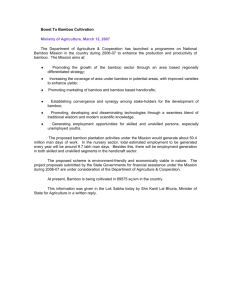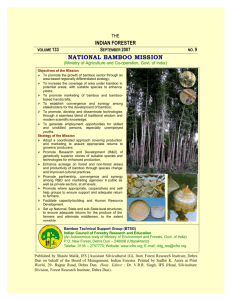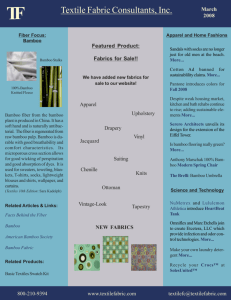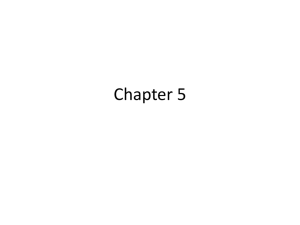Boston Globe 11-05-06 Bamboo's twofold appeal: It's ecofriendly and stylish
advertisement
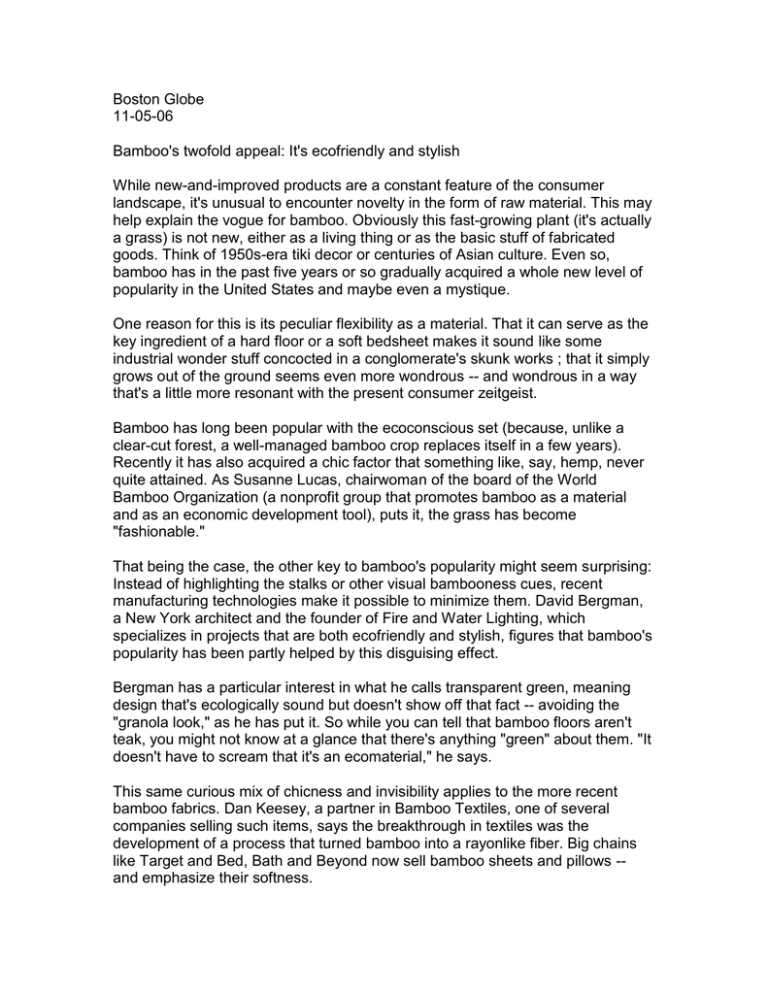
Boston Globe 11-05-06 Bamboo's twofold appeal: It's ecofriendly and stylish While new-and-improved products are a constant feature of the consumer landscape, it's unusual to encounter novelty in the form of raw material. This may help explain the vogue for bamboo. Obviously this fast-growing plant (it's actually a grass) is not new, either as a living thing or as the basic stuff of fabricated goods. Think of 1950s-era tiki decor or centuries of Asian culture. Even so, bamboo has in the past five years or so gradually acquired a whole new level of popularity in the United States and maybe even a mystique. One reason for this is its peculiar flexibility as a material. That it can serve as the key ingredient of a hard floor or a soft bedsheet makes it sound like some industrial wonder stuff concocted in a conglomerate's skunk works ; that it simply grows out of the ground seems even more wondrous -- and wondrous in a way that's a little more resonant with the present consumer zeitgeist. Bamboo has long been popular with the ecoconscious set (because, unlike a clear-cut forest, a well-managed bamboo crop replaces itself in a few years). Recently it has also acquired a chic factor that something like, say, hemp, never quite attained. As Susanne Lucas, chairwoman of the board of the World Bamboo Organization (a nonprofit group that promotes bamboo as a material and as an economic development tool), puts it, the grass has become "fashionable." That being the case, the other key to bamboo's popularity might seem surprising: Instead of highlighting the stalks or other visual bambooness cues, recent manufacturing technologies make it possible to minimize them. David Bergman, a New York architect and the founder of Fire and Water Lighting, which specializes in projects that are both ecofriendly and stylish, figures that bamboo's popularity has been partly helped by this disguising effect. Bergman has a particular interest in what he calls transparent green, meaning design that's ecologically sound but doesn't show off that fact -- avoiding the "granola look," as he has put it. So while you can tell that bamboo floors aren't teak, you might not know at a glance that there's anything "green" about them. "It doesn't have to scream that it's an ecomaterial," he says. This same curious mix of chicness and invisibility applies to the more recent bamboo fabrics. Dan Keesey, a partner in Bamboo Textiles, one of several companies selling such items, says the breakthrough in textiles was the development of a process that turned bamboo into a rayonlike fiber. Big chains like Target and Bed, Bath and Beyond now sell bamboo sheets and pillows -and emphasize their softness. All of this has happened at a time when eco-awareness has evolved into the sort of trend reducible to a Vanity Fair-friendly formulation like "green is the new black." And of course, becoming an "it" material is a double-edged business. For starters, there isn't just one kind of bamboo; there are about 1,400 species, according to Lynn Clark, a professor at Iowa State University who has studied bamboo for decades (and is still discovering new species). Bamboo flooring and other woodlike uses can have a range of qualities depending on whether the stalks were harvested at the appropriate age: Too young or too old and the results can be too soft or too brittle and easily damaged. Moreover, much of the bamboo that makes its way to the American consumer comes from China, which means that it's being shipped around the world -generally a greenie no-no. Finally, overseas bamboo harvesting is often opaque, with little information available about working conditions or how crops are being. TreeHugger, an environmental-lifestyle website, has even argued that sometimes a maple floor made from locally harvested wood under a forest-management certification program can be a more environmentally sound choice. But that's the flip side of an ecomaterial transcending its eco-ness: Bamboo has the vague aura of being green-friendly but not too crunchy -- trendy, in other words. Bamboo has become so well known, in fact, that Bergman, the architect, sometimes steers clients away from it. "I've had one or two instances," he says, "where we've said, 'It's too done now.' You don't want to do something so of-themoment that it dates the design."

